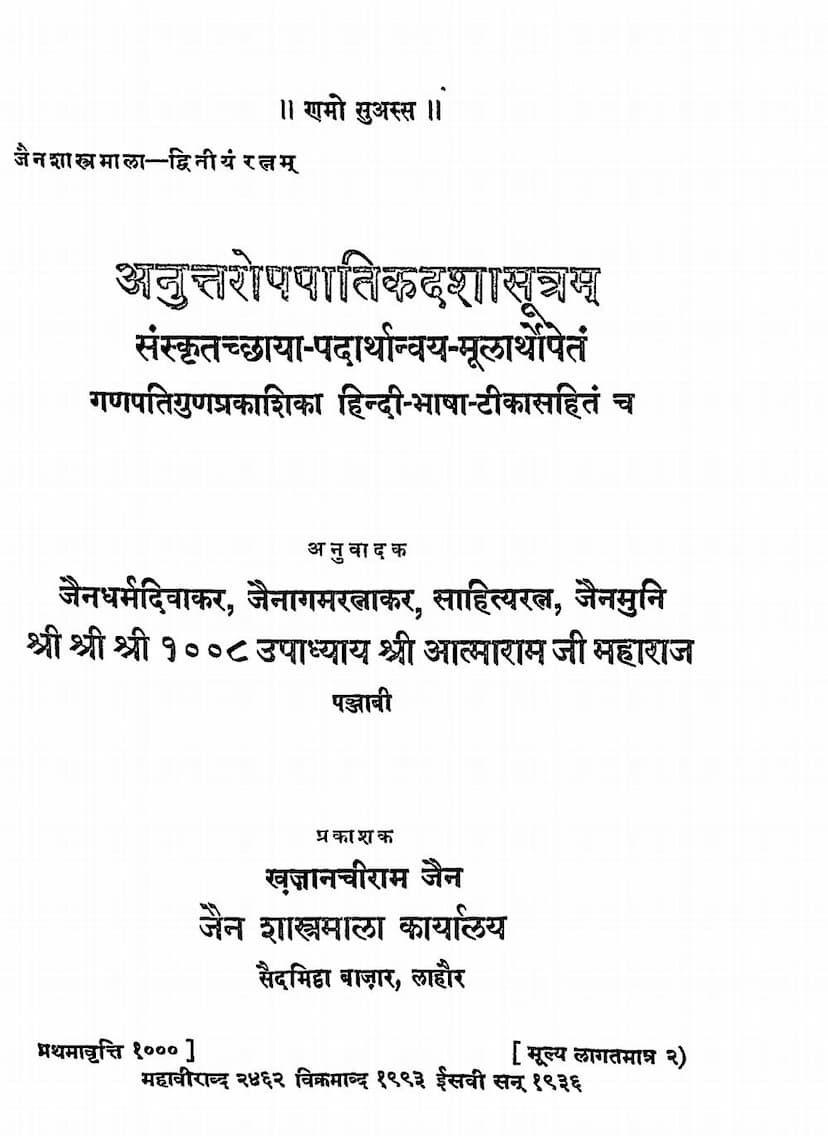Anuttaropapatikdasha Sutram
Added to library: September 1, 2025

Summary
This document is the "Anuttaropapatikadasha Sutram," the ninth Anga (limb) of the Jain Agamas, authored by Upadhyay Shri Atmaramji Maharaj and published by Jain Shastramala Karyalay in Lahore in 1936 CE.
The book serves as a commentary and Hindi translation of the original Sanskrit text.
Introduction (Pages 3-6):
The introduction emphasizes the ephemeral nature of worldly pleasures derived from material possessions, contrasting them with the enduring bliss of spiritual peace. It laments the current era's inclination towards materialism and the resulting widespread unrest and dissatisfaction. The author highlights the wisdom of ancient times, where a simpler life was filled with contentment due to adherence to morality and the pursuit of spiritual peace.
The path to spiritual peace, according to the introduction, lies in the study of scriptures (Swadhyaya) and the company of virtuous souls (Satsang). Through these, one develops self-awareness, discriminates between the self (Jiva) and non-self (Ajiva), and strives for right faith (Samyak Darshan) and righteous conduct (Charitra). Even kings and wealthy individuals, recognizing the limitations of worldly pleasures, renounced them in their quest for spiritual tranquility, as taught by Lord Mahavir Swami, who emphasized knowledge (Vidya) and conduct (Charitra) as the primary means to achieve liberation.
This book aims to impart these virtues to the public.
Content Summary of the Sutra:
The "Anuttaropapatikadasha Sutram" details the lives of individuals who, having renounced worldly enjoyments and diligently practiced penance and conduct, attained rebirth in the "Anuttara" (supreme) celestial realms. Though their human lifespan was short, preventing them from achieving immediate liberation, they are destined to attain it in a subsequent birth due to their advanced spiritual state.
The text is structured into three sections (Vargas):
-
First Section (Prathamo Varga): This section describes the lives of ten individuals, commencing with Jali Kumar. The introduction to this section explains the lineage of the text, with Jambu Swami seeking clarification from Sudharma Swami regarding the teachings of Lord Mahavir after his Nirvana. The Ninth Anga, "Anuttaropapatikadasha," is presented as a discussion between Jambu Swami and Sudharma Swami. The first study within this section focuses on Jali Kumar, whose life is presented as an example of spiritual dedication. The introduction emphasizes the importance of study and guru-bhakti.
-
Second Section (Dwitiyo Varga): This section presents thirteen studies, beginning with Dirghasen Kumar. It continues the theme of individuals reborn in the Anuttara heavens after dedicated practice. The disciples are presented as having undertaken specific penances, like monthly fasting (Masika Sanlekhana), leading to their elevated rebirth.
-
Third Section (Tritiyo Varga): This section features ten studies, starting with Dhanya Kumar. The life of Dhanya Kumar is elaborated upon in detail, highlighting his renunciation of worldly pleasures, rigorous penance, and eventual rebirth in the Sarvarthasiddhi celestial realm. His physical transformation due to extreme penance is vividly described through various analogies. The text then briefly outlines the lives of other individuals like Sunakshatra Kumar, Rshidas Kumar, Pelaka Ramaputra, Chandrika Kumar, Pṛṣṭhimātṛkā Kumar, Pedhalaputra Kumar, Pṛṣṭhimāyī Kumar, and Vehalla Kumar, emphasizing their spiritual practices and rebirths in the Anuttara heavens. The section concludes with a detailed account of Dhanya Anagar's final spiritual practices, his attainment of a state of detachment, and his rebirth in the Sarvarthasiddhi Viman. The section highlights the importance of sincere conduct, the impact of spiritual teachings, and the results of penance.
The final chapter (Chapter 6 in the provided text) serves as a concluding summary, reiterating the qualities of Lord Mahavir Swami and the significance of the Anuttaropapatikadasha Sutram as the ninth Anga. It underscores the importance of emulating the virtues of great souls like Dhanya Anagar and the pursuit of spiritual knowledge and conduct for ultimate liberation.
The book is rich in its use of analogies and comparative narratives drawn from other Agamic texts like the "Shatakavasthana" and "Gyata-Dharmakathanga Sutra" to illustrate the spiritual journeys of these ascetics. It concludes by emphasizing the path of knowledge and conduct as the means to achieve liberation and the ultimate attainment of the Anuttara heavens.